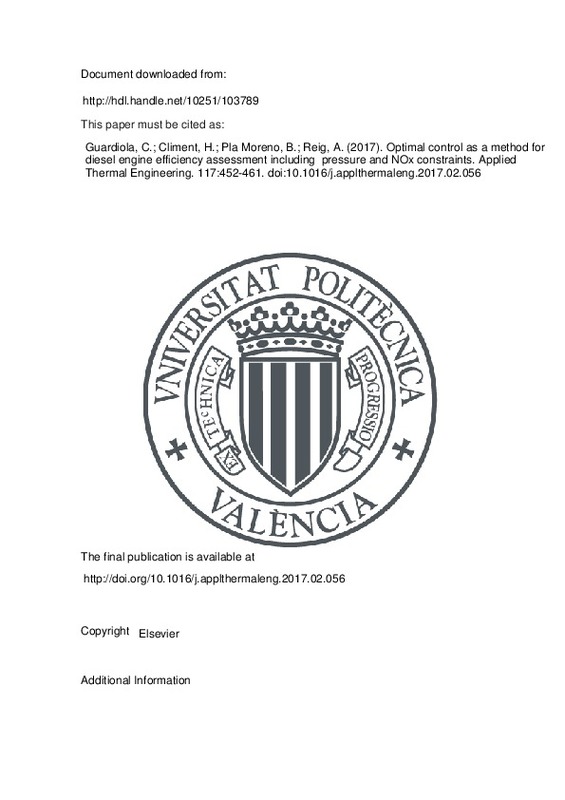JavaScript is disabled for your browser. Some features of this site may not work without it.
Buscar en RiuNet
Listar
Mi cuenta
Estadísticas
Ayuda RiuNet
Admin. UPV
Optimal control as a method for diesel engine efficiency assessment including pressure and NOx constraints
Mostrar el registro sencillo del ítem
Ficheros en el ítem
| dc.contributor.author | Guardiola, Carlos
|
es_ES |
| dc.contributor.author | Climent, H.
|
es_ES |
| dc.contributor.author | Plá Moreno, Benjamín
|
es_ES |
| dc.contributor.author | Reig, Alberto
|
es_ES |
| dc.date.accessioned | 2018-06-11T04:30:58Z | |
| dc.date.available | 2018-06-11T04:30:58Z | |
| dc.date.issued | 2017 | es_ES |
| dc.identifier.issn | 1359-4311 | es_ES |
| dc.identifier.uri | http://hdl.handle.net/10251/103789 | |
| dc.description.abstract | [EN] The present paper studies the optimal heat release law in a Diesel engine to maximise the indicated efficiency subject to different constraints, namely: maximum cylinder pressure, maximum cylinder pressure derivative, and NOx emission restrictions. With this objective, a simple but also representative model of the combustion process has been implemented. The model consists of a OD energy balance model aimed to provide the pressure and temperature evolutions in the high pressure loop of the engine thermodynamic cycle from the gas conditions at the intake valve closing and the heat release law. The gas pressure and temperature evolutions allow to compute the engine efficiency and NOx emissions. The comparison between model and experimental results shows that despite the model simplicity, it is able to reproduce the engine efficiency and NOx emissions. After the model identification and validation, the optimal control problem is posed and solved by means of Dynamic Programming (DP). Also, if only pressure constraints are considered, the paper proposes a solution that reduces the computation cost of the DP strategy in two orders of magnitude for the case being analysed. The solution provides a target heat release law to define injection strategies but also a more realistic maximum efficiency boundary than the ideal thermodynamic cycles usually employed to estimate the maximum engine efficiency. (C) 2017 Elsevier Ltd. All rights reserved. | es_ES |
| dc.description.sponsorship | Thanks are due to the Ministerio de Economia y Competitividad by its financial support through project mu-Balance (TRA2013-41348-R). | |
| dc.language | Inglés | es_ES |
| dc.publisher | Elsevier | es_ES |
| dc.relation.ispartof | Applied Thermal Engineering | es_ES |
| dc.rights | Reconocimiento - No comercial - Sin obra derivada (by-nc-nd) | es_ES |
| dc.subject | Diesel engine | es_ES |
| dc.subject | Combustion analysis | es_ES |
| dc.subject | Optimal control | es_ES |
| dc.subject | Dynamic programming | es_ES |
| dc.subject.classification | MAQUINAS Y MOTORES TERMICOS | es_ES |
| dc.title | Optimal control as a method for diesel engine efficiency assessment including pressure and NOx constraints | es_ES |
| dc.type | Artículo | es_ES |
| dc.identifier.doi | 10.1016/j.applthermaleng.2017.02.056 | es_ES |
| dc.relation.projectID | info:eu-repo/grantAgreement/MINECO//TRA2013-41348-R/ES/EVALUACION DEL EFECTO DE LA TRANSMISION DE CALOR EN LA CAMARA SOBRE LA EFICIENCIA DE MOTORES DIESEL DE PEQUEÑA CILINDRADA/ | es_ES |
| dc.rights.accessRights | Abierto | es_ES |
| dc.date.embargoEndDate | 2019-05-05 | es_ES |
| dc.contributor.affiliation | Universitat Politècnica de València. Departamento de Máquinas y Motores Térmicos - Departament de Màquines i Motors Tèrmics | es_ES |
| dc.description.bibliographicCitation | Guardiola, C.; Climent, H.; Plá Moreno, B.; Reig, A. (2017). Optimal control as a method for diesel engine efficiency assessment including pressure and NOx constraints. Applied Thermal Engineering. 117:452-461. https://doi.org/10.1016/j.applthermaleng.2017.02.056 | es_ES |
| dc.description.accrualMethod | S | es_ES |
| dc.relation.publisherversion | http://doi.org/10.1016/j.applthermaleng.2017.02.056 | es_ES |
| dc.description.upvformatpinicio | 452 | es_ES |
| dc.description.upvformatpfin | 461 | es_ES |
| dc.type.version | info:eu-repo/semantics/publishedVersion | es_ES |
| dc.description.volume | 117 | es_ES |
| dc.relation.pasarela | S\335920 | es_ES |
| dc.contributor.funder | Ministerio de Economía, Industria y Competitividad | es_ES |







![[Cerrado]](/themes/UPV/images/candado.png)

